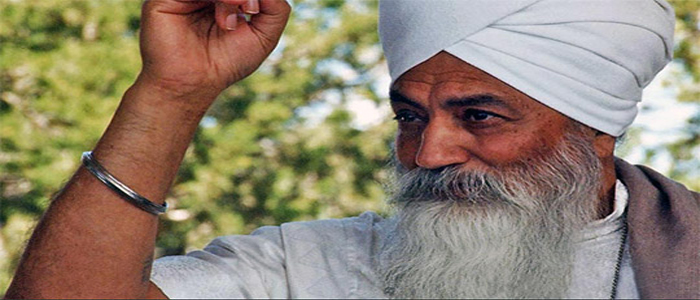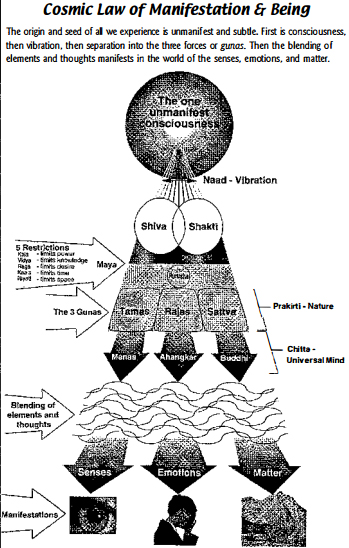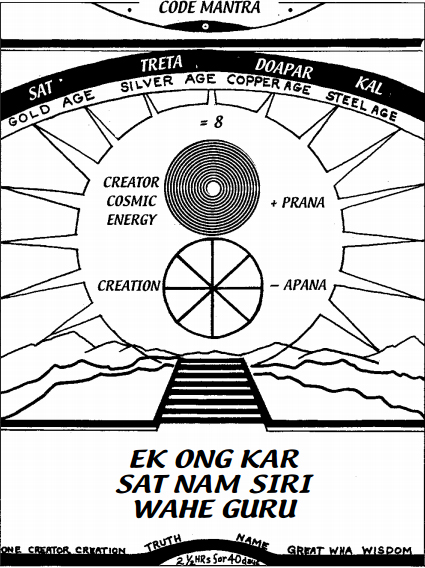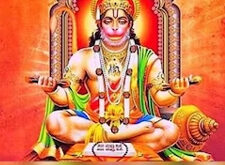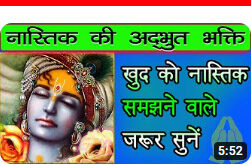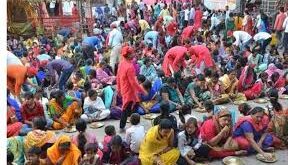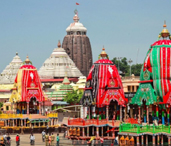This chapter includes … Introduction to Yogic Philosophy Common Attitudes in Eastern Philosophies The Chain of Being & the Ladder of Subtlely Cosmic Law of Manifestation & Being (diagram) G.O.D. Maya, the Tattvas & the Gunas Yogi Bhajan on the Tattvas The Three Gunas You, the Tattvas & the Gunas (A lecture by Yogi Bhajan) The First Five Teachers Ether, Air, Fire, Water, Earth (table) The Journey of the Soul-Karma, Dharma, Reincarnation, & Liberation Yogi Bhajan on Dharma Yogi Bhajan on the Theory of Cause and Effect Cosmic Cycles (the Yugas) The Ashtang Mantra for this Age (A lecture by Yogi Bhajan) Code Mantra of the Aquarian Age (diagram) COPYRIGHT YOGI BHAJAN 2003 208 208 209 209 209 210 210 210 211 211 212 213 213 213 215 215 216
There can be many trips, but there is only one way to reach higher consciousness: that is the way of righteous living. There is no other way, every other way will be hanky panky. But the moment you decide, come what may, I am going to give myself to the way of righteousness within me, you will be surprised to see that everything else in this whole world will fall into place for you. -YOGI BHAJAN
Introduction to Yogic Philosophy THE MEANING OF PHILOSOPHY IN THE WEST AND THE EAST IS RADICALLY DIFFERENT. In the West philosophy usually means the analytic study of knowledge, the use of language and concepts to analyze and understand our environment, lives and the universe itself. It is removed from experience and application. In the East, philosophy is one with experience. The goal is the establishment of a capacity for the perception of reality by the practitioner. Hence the philosophy of yoga is a chronicle of the experiments of individuals to perceive reality, and their efforts to leave markers and mechanisms so that those who follow can attain that same capacity. Philosophy requires the preparation of the mind and body of the student to perceive the subject of the inquiry. When we look back to yogic sources and texts we find that the writings are very concise. The sutras and holy writings are comprised of short aphorisms. For deep understanding, they need commentary and guidance from an enlightened teacher, along with direct personal experience. Some people think this situation may have come from the absence of the printing press. But at the time they were written, there was no lack of willing labor to reproduce long documents. Their brevity and obscurity may have come from several sources: I) The belief that a teacher is essential for the process of learning. The act of testing and of surrender is essential to being able to perceive certain truths. The interaction with a teacher who will poke, provoke, confront, and elevate is the means of preparing the instrument of the mind. 2) The realization that the Infinite cannot be accurately represented in any conceptual form. It can be woven into the process of knowing and into the knower. But every system will fall short of the goal and thus be false. 3) An effort to obscure the findings in the sutras. This may have been to test the student, or it may have been for social reasons to restrict the knowledge of transformation only to people who have the special key or guide. 4) Short verses (sutras) are easier to memorize than long texts, and can serve as a mental “hook” on which to hang a much deeper concept. All of this is because philosophy in the East is an active catalyst that stimulates change in the student. It is potent. The results are not abstract or intangible as we think of philosophy in the West. The student is cautioned to choose only the most tested sources of teachings and warned not to simply collect many opinions. Good philosophy implies a well-practiced discipline that generates a coherent vision of the self and of reality. Our purpose here in taking a brief look at philosophy is to
acquire a foundation to understand the framework in which classical yoga is explained. Each major philosophic system in the East is called a darshana (which means “presence” or vision). Of the six major systems, the oldest is Samkhya. This system (combined with Vedanta) forms the background for yogic philosophy. Common Attitudes in Eastern Philosophies All of the philosophic traditions share certain common attitudes, which are the texture of the investigation of the world and the self: I) Direct and personal knowledge. All the revelations that originate in the ancient scriptures come directly from the deep meditative personal experience of sages and saints. Each great seer described the results of his or her inner experimentation and the methods they used for testing that vision. 2) Pragmatism. After one has experienced a vision, then what? A vision cannot be maintained and expressed on one’s daily life without the elevation of a daily sadhana or discipline to maintain it. The practice of a way of living and effective meditation techniques to elevate the consciousness. allow these systems to be experienced by a student of any time period. 3) Suffering. All systems begin with the recognition of the desire to escape the three sufferings: – Heavenly suffering, provoked by Gods and fate. – Earthly suffering, caused by the movements of nature. – Inner or organic suffering, due to imbalance in the psycho-physical system. Eastern philosophies do not dwell pessimistically on suffering. They simply note that it is everywhere and then inquire into the ways it can be transcended and transformed. 4) Law of karma. There is no action without an effect. The law of action and reaction is an absolute rule of nature. This gives the individual both potency and responsibility. The task is to not take actions that produce negative effects. This requires clear understanding of the sequence and consequence of our actions. Once we act, we speak; once we plant a seed in the fruitful universe, the effect will always come to pass in its own time. S) Ethical and behavioral commitments. Every path has proscribed and prescribed roles. behaviors. and attitudes that lead us into the experiences of the higher self. These are sometimes simply known as “do’s” and “don’t’s.” 6) Yoga practice. All the philosophies that are active include some form of meditation, exercise and prayer. This is true of all the Eastern systems as well as of all esoteric Western traditions. 7) Pluralistic & holistic attitudes. No system claims to have captured the whole vision. The reality they see is everywhere. Therefore the entire universe becomes familiar and something to be learned from. There is great tolerance combined with firm commitments.
The Chain of Being Er Laaaer of Subtlety Materialism and modern science favor a view of the world as flat, that all things that exist can be reduced to a common material substance that has the same order of being and existence. The yogi, the mystic, and all traditions of enl ightened teachers share a different view that encompasses the scientific view but extends way beyond it. They see the universe as a great chain of being. It is an hierarchical network of interconnected realms. The universe has many levels or gradations of Being. It is complex and multi-layered. There is a ladder of subtlety that consciousness must climb if one is to understand the true nature and inter-connectedness of Reality. This ladder exists both within the universe as a whole, and within each one of us.
At one end of the ladder is the material world described by science. It is full of atoms and molecules. It is real. It exists and has physical laws. At the other end of the ladder is Beingness itselfthe Transcendent Reality beyond mind and definition. That reality can never be contained or reduced to simple material components. Nor can it be comprehended by any model the mind may devise. In fact the ladder is more like a path through levels of consciousness in which things evolve and devolve. Before the category of matter exists, the mind exists. Before that and before time, consciousness exists. In the materialist’s view there is only one way to affect things, since there is really only matter and its laws. To the yogi, we can both affect things through the material world, and by combining elements in the more subtle realms of the ladder. This is similar to a lever. If you press the lever close to the fulcrum (at the realm of physical action) you can create change, but it takes a tremendous amount of effort. If you press on the lever far from the fulcrum (at the subtle levels) you can create great changes with little effort. Physical real ity is created down through the layers of Being, from subtle to physcial. If you create a combination of elements in the higher mind, the buddhi, it will lead to a manifestation through the senses and finally be realized in the physically visible world. The materialist can use only the epistemology of differences, statistics, and logic. The yogi finds effective uses for all the ways of knowing: differences, similarities, resonances, and identity. The sages have given many psycho-cosmic maps of this ladder of Being. Patanjali, Samkhya philosophy, Kashmir Shaivism, and teachings of the saints and Gurus depend on this central concept. An understanding of this vision will unlock many secrets in the yoga literature. It will allow you to approach your sadhana with depth and effectiveness. A person who has never heard an orchestra will appreciate their first concert. But the same person when versed in an instrument, steeped in music appreciation, and having attended many concerts will have a depth and richness of experience that is far greater. Being aware of the map of the chain of Being will introduce you to the instruments of creation, so you can hear its music and understand the mechanism of creation more clearly. G.O.O. At the top of the Ladder of Being there exists only pure Consciousness-the One, or G.O.D. (That force which is always o: Generating, Organizing, and Destroying). i “God is not living on the seventh story, and no lift goes to Him. -g God is you. He is your expression. He is your identity in existence. ” That is why God is everywhere. Because wherever you are, God is. J Because wherever you generate, organize, and destroy, it is a frac tion of the same that is already prevailing in the universal human. j Therefore, we can conclude that the human is the image, or the ?!c finite activity, of the universal activity in operation.” -YOGI BHA]AN, IN THE TEACHINGS OF YOGI BHA}AN
MayaJ the Tattvas a- the Gunas PURE CONSCIOUSNESS EXISTS BEYOND THE CREATION. God decided to come into the Creation to have an experience. At that point a change occurred. That change came in stages like the gradual changes in the colors of the dawn. In each stage there is a little less Oneness, a little more separateness. It is similar to the consciousness of a new born baby. When a baby is born, its consciousness is undifferentiated. It experiences itself as merged into everything. Gradually as the child gets older, it begins to differentiate between that which is ” me” and that which is “not me.” The process that makes everything seem separated is called maya. Each stage of separateness has its own qualities. The yogis call each stage a tattva. There are about 31 stages going from complete Oneness down to pure individual atom separateness. The final five of these tattvas give rise to what we experience as the qualities of matter and the sensations we are used to. Creation has layers. It is subtle. In the West we pay attention only to the last most dense layer of matter. Guru Nanak and other saints and sages tell us that there are worlds upon unseen worlds. The mind senses all those seen and unseen worlds. Each of us maintains a special balance of the tattvas with our mind in order to have a strong body and a unified personality. The quality of our life. our mind, and our health is maintained by the tattvas. The five densest of the tattvas, which we experience as qualities in the body and in all matter, are: earth, water, fire, air, and ether. These are the same ‘elements’ known to Hermetic science, Chinese medicine and medieval alchemy. These five earthly tattvas are qualities in our senses and in the world. These five tattvas engage three types of behaviors or qualities, called gunas, that determine the The ThrelGinas altitude and attitude of your life. ; , >::-: .. . ; · . . . . ”t’ Taniasic–‘Animal · i,Persoriatity Split . . A.ngry. eonfed. Stupid lmput5Wr0/ · · God.asf1i , ;[Jbli3si 2Earthlirtg Human Qemanding. PQsitive •.. Act[ve Yellow Spectrum Em tional. Commotional God as Companion Sattvic.;_Angelic Hu an P,ersqnality Unified to Spirit ·,.:- . ‘ · Greer,J Spectrulll 1fntu1tive. SeoitiV These three gunas are: tamas, rajas, and sattva. If we use the mind in the sattvie guna, which is clarity and lightness, it makes us saintly and enriches us to be crowned as a Lord of the Universe. We are both connected and effective. If we use the rajasic guna, which is forcefulness and will, it empowers us to be the king of the territory, to gain jurisdiction wherever we feel, see, and live. If we use the tamasic guna, which is dullness, unawareness, attachment, and functioning only from need and instinct. it makes a human an animal in this world without any blessings or guidance from the heavens. To be happy as a human being, we must recognize our basic guna
and live to it. We must have an effective personality. Our tattvas and gunas must support us. Our mind needs to project in unisonness the power of our facets to deliver our own angelic self. We must call on our own spiritual and genetic strength. We have been given everything we need. -FROM THE MIND: ITS PROJECTIONS AND MULTIPLE FACETS Yogi Bhqjan on the Tattvas There are five elements of which you are made: water, fire, air, ether, and earth. These five elements have five projections: lust (kam), anger (krodh), greed (lobh), negative ego (ahangkar), and attachment (moh). When you are made of mud, how can you get rid of mud? When you are made of earth, how can you get rid of earth? Nobody can get rid of the five elements of which he is composed. All he can do is channel their projections. If you go to a teacher and 1MiiYQThp7es· ·efit$ i :s the· illu r!i ofseparat j Wive Tattvas re·*mest1J :Of the levels of separateness, xperienced ti:i.;rthly · • e . n . ts: ea . . . ·.’.f ,’ v/t’er, Ji . . re . . . · . · • . • . . · air • . •.·.,. and ethet · · ·.·.· · · · ·• u· <;. ;; .. · .. . .. ; · · • · .• ;& ;Gunas · The three qualities on ‘be!Hg’or·behavior:.sattlla. . tama, d fa- ‘ · • ;,…..,,_,_,. he says, “Get rid of them,” you already know that, so what good is it to say so? It is impossible, because attachment is the earth faculty; anger is the fire faculty. How can you get away from these? You can’t, because they are projections of the five tattvas. But you can channel them positively. You can divert this energy for positive ends. ., Lust (kam) Water-Apas tattva Instead of being lustful to exploit new bodies, a man can see in a woman, not an object of exploitation, but a mother or sister image to be respected. He can keep his dignity, keep his respect, and change his attitude from exploitation to service. ., Anger (krodh) Fire-Agni tattva. Instead of directing anger at others, be angry at your own negativity. ., Greed (lobh) Earth-Pritvi tattva Instead of being greedy to possess things, be greedy to spread truth to all people; to possess a high caliber; and to become a great saint or a great teacher. ., Negative ego or pride (ahangkar) Ether-Akasha tattva Instead of being an egomaniac, identify yourself with the Infinite. Have pride and gratitude that God made you a human. ., Attachment (moh) Air-Vayu tattva Instead of being attached to earthly possessions, be attached to the whole universe! Be attached to the idea of a healthy, happy, holy life; and to not wanting to see people suffer.
You .. the Tattvas & the Gunas SAINTS AND SAGES HAVE TAUGHT MANKIND THAT whatever elements are found in the constitution of the Infinite Universe will also be found in the human body. The Universe is the entire Cosmos; and we are a microcosm of the entire Cosmos. If we were to take a thimbleful of sea water and examine it closely, we would find by chemical qualitative analysis that the constituents of the sea water in the thimble are identical to those of the vast ocean. Similarly, the constituents of our individual bodies are identical to those of the Universe. It would be a strange finding if some element were found inside the human body which differed from the elements of the Universe. For there is One Creator who has created this Creation; and all manifested things are born from the One Source of all. THE ELEMENTS AND GUNAS EXPRESS THEMSELVES Our personality is dependent on which of the five gross elements predominates in our nature. If a person has the akasha tattva (the etheric element) predominating, then he will be the happiest. most carefree being on this planet Earth. Yet, the operations of the akasha tattva are not perceptible to our sense organs. The sattva and rajas gunas. or forces, manifest in the vayu tattva. the element of air. This vayu is the vital force or prana in the body. It produces the cells and precious seeds. It keeps all of the bodily organs active and healthy, and circulates the blood and
other fluids throughout the body. Vayu is not as subtle as ether (Akasha). Though we cannot see vayu, we feel its touch. The influence of the sattva guna is present in the first two tattvas. However, it is the force of rajas which expresses itself in agni tattva, the light. or fire energy. The light inside the body expresses itself in and through the gift of sight. Agni tattva is the main motive energy in the body-digesting our food, producing blood and other fluids, and sustaining the body. It is responsible for the nourishment and growth of the body. The fourth essence is water-apas tattva-a manifestation of the forces of rajas and tamas. The operation of this element in the body is our capacity for taste, just as ether governs sound; and air governs sight. Also, gland secretions, blood, and semen originate from this element of water. Pritvi tattva, the basic element of earth, is an expression of the force of tamas. It mainly operates through our sense of smell. All the solid parts of the body-bones. skin, flesh, teeth, and marrow-originate from this physical element of earth. These five elements maintain the well-being of our physical body. In the great Universe, we likewise observe the play and interplay of the three great forces-vayu, agni, and apas. When we see lightning and thunder in the heavens, this is the interplay of forces. Without such interplay life could not go on . The operations of a particular tattva comprise the entire bodysystem. There are main centers as well as subsidiary centers of
THE TA11VAS Er THE GUNAS operation. The chief center of operation of the akasha tattva (ether) is the throat-the space between the collar-bone and the nape of the neck. This is the uyama-granthi region of the body, which comprises the following principal glands: thyroid, parathyroid, salivary, and tonsils. The essential secretions of these glands help mold our minds and keep them nourished. In vyama-granthi. sattva guna predominates. For this reason, a person with a supremacy of the vyama-granthi in his body possesses a mind in tune with the Supreme Consciousness. The vyama-granthi of females is much stronger than that of males. Therefore, in a woman we find that endearing qualities such as affection, love, unselfishness, and steadfastness are conspicuously present. The main center of operation for the second tattva, vayu (air) is the chest region, which is also the seat of vayu-granthi. It includes five principal organs and glands: lungs, heart. thymus, cell producing glands and their subsidiaries. Air is the main protective element in the body. Anyone having vayu-granthi in a strong and healthy condition acquires self-control, balanced temperament, purity of thought, and becomes a great. unselfish worker. The agni-granthi, or fire center, manifests through the spleen, liver. pancreas, and adrenal glands. Just as the heat of the sun makes life possible on Earth, the heat of the agni tattva sustains life in the body. The day this internal fire goes out means death to the individual as surely as this world would die if the sun refused to shine. Persons with a supremacy of this agni tattva are very vigorous, full of perseverance, and become untiring workers. They have a wonderful capacity for leadership and a directness of manner and speech. The kidneys, sex glands, and the lymphatic system are physical manifestations of the water, or apas tattva. We group them under the term varuna-granthL People with a predominance of the varuna-granthi are very amiable. In their dealings with others, they are very sweet and pleasing and have a charming manner. The foundation of the physical structure of our body-bones and flesh-is in the prithvi tattva, the earth essence. People with a predominance of pritvi-granthi usually have a body heavy with an excess of blood, flesh, and fat. They are lazy, but also patient, and they keep away from all conflicts and anxiety-producing concerns. MAINTAINING THE BALANCE The mystery of the creation and the mystery of our bodies can be explained in terms of the tattvas. The trinity of three of these
elements-air, fire and water-are the primal constituents of the material world. The whole material system would perish if this trinity were thrown out of balance. And the same trinity of three great elements in the body maintains the breath, body temperature. and so on. They build and nourish the body with the help of blood, secretions. and other fluids produced in the body. If these are thrown out of balance, we ultimately fall prey to disease. FROM THE FOUNDATION OF THE TATTVAS-TRANSCENDENCE For the spiritual man, the sadhak, it is not enough to just have a healthy body. He realizes only too well that this body is a vehicle, which he leaves behind when he reaches his destination. Similarly, we must transcend the centers in the body over which these essences or tattvas rule, to successfully relate our essence to the Essence of the Universe. A sadhak must not allow his consciousness to remain rooted at the lower centers of earth, water, and fire. For it is only when he raises his consciousness that he gets in tune with Divine Love (the heart center) and Universal Intuition (the throat center). And beyond even this, the true yogi must raise himself. He must merge totally with the Infinite. Some yogis get tattva-siddhi by meditating on a particular center of consciousness. For example, meditating on the ether-its sound and its light for 40 days-will lead to a stage where that ether serves them. But it serves them as a slave who will rebel when free of the master. For when such a yogi who depends on form and the finite in his life dies. he cannot relate to the Infinite; he cannot transcend. And he becomes an earthbound spirit for incarnations. It is only by mastering a mantram or the Shabd Guru. the sacred sound current, that we move from gross to subtle and from subtle to Infinite. Because: Mantram siddhim siddhim parmeshram. By perfection of the mantram, God will serve one perfectly. It is not enough to simply relate our physical elements to the cosmic elements. That identification can be a first step. But after that we must learn a technical know-how by which we mentally and spiritually tune into the Infinite Supreme Consciousness. And that know-how is called yoga: the science of union with the Higher Consciousness. That is each person’s birthright, a sacred duty, a longing-to belong to the Supreme Consciousness. Through Kundalini Yoga, the yoga of awareness, the yoga of the Aquarian Age, we can transcend our finite nature and merge with the Infinite.
The journey of the Soul-Karma Dharma Reincarnation Er Liberation
I . ‘i , .
.
·
‘
··
. ‘ . . i . . ;!
morat,and.physical a on , I
‘ . ‘ . . .. .· ….. l
Ego a ac s to and j�entiJie ‘
“us with obje ts� feeli�gs. an
oughts’ , .. �e attachrnen
t
. .
. . . ·
.
. ·
,create a 1 s toward certain
¥ > . ·. . .” :
,:
·.
: .
. >’,;.:
·
� … :,: ,lines o�;action . . ·lnstead of
‘acting]’;�e read;.,Karm�s are’
the,conditions �quired”Jn . \;
�rd�r to bala);lce or. cdhlplet�
‘th�� tendb1tles:·
·
{_<
tL ..
w�
I .. • ‘• . … · :· .
,
.:f-:
.
‘
‘Oharmals the p of;life
�·bC>ve ithe eel . 6
·
‘rma’;;
)t . ·
.d.�ith our solilan ;
1ctestiriy, ;Wh�re allouracti n
k. · . :·<‘\ . . .
. . :· ·.
.. ;’ ;c_,. ‘ ,.
:are toWards theJnfihite. lt is
��tion ‘Zvithoub” r���tion; or
a: ,, . .
·
� · .)�· :
!{ ·· . , ‘
karma’�
�’Rei carnation is’the.
t . .
.
cycle ()f bittf1 ana de�tf1;
‘spur�ed orfb� karma. p’ur
‘thol.lgtJts•a �·,�ctions•cr�t
’cause5� hi2fi rhttst be”’ ·.
‘comp �ted,. tfl!JS Creati.ffig
hul” r1eXt: incai�ation ..
”;
·
::”>””””i'”};.:�
·
,. .
: ;l’,j..’
‘Libe ation �� rele�$eJr6fu
‘t:h�: .cycle of:Bilth �J’1d��t6.
�Wl;en ·actions no lori er ·
�reate<hrma, when’ we liye
dha( a. rather. tfl�h
..
. . . . .
. a a, we are said to b
t /
.
i<‘. · · .:._,. . .
. .
liBerated ..
· �.� ·
· �- ii;;;J;,,;�:. .
.. �
In Kundalini Yoga we don’t
worry about the effect. we
worry about the cause,
because cause has an effect.
Effect can never happen
without cause: consequences
shall never happen without
sequence. If a person can be
aware enough to know the
trend of the sequences,
he can control the
consequences.
-YOGI BHAJAN
AS THE SOUL JOURNEYS
through the vast stages of
being, towards awareness of its
true nature of Oneness, the
individual is subject to the law
of karma. In How to Know
God, the Yoga Aphorisms of
Patanjali, it states:
“His desires and acts regulate
the speed of his progress.
He builds or removes his own
obstacles to enlightenment. His
present state is continually
being conditioned by the karmas
of his past. and continually
productive of future karmas.
Death does not interrupt this
process. Neither does rebirth .
The individual is merely reborn
with a body, a mind, a character
and social surroundings which express, as it were, the sum
total of his karmic balance at that particular moment in time.
“The doctrine of reincarnation is exceedingly unpalatable to
many people because it makes each one of us directly responsible
for his present condition. We all dislike having to face this responsibility,
and some of us prefer to blame God, or our parents, the
existing political system or anything outside of ourselves for making
us what we are. If we deny reincarnation and claim that this
birth is our first, we are, in fact, disclaiming responsibil ity for our
condition, since it then logically follows that this condition must have been ordained by God, or brought about by the influences of heredity and environment. Hence-if we have been born physically or economically underprivileged-we are provided with a permanent grievance, which permits us to spend a lifetime sulking and cursing our fate, and with a permanent excuse for all our own weaknesses and failures. This doctrine of reincarnation, which at first seems so grim and heartless, actually implies a profoundly optimistic belief in the justice and order of the universe. If it is we-and not God, or our parents, or our fellow men-who have made our present predicament, then it is we who can change it. We have no excuse for self-pity and no reason for despair. We are not helplessly doomed. We are under no mysterious prenatal curse. All we need is courage and a determination not to give up the struggle.” Yogi Bhqjan on Dharma When karmas remain so do you. Karma has to become dharma. Dharma is where the account is cleared. It is where your discipline and commitments make you positive and graceful. Then you break out of your cocoon and become a leader, elevate all, and leave a legacy. That ability to turn negative into positive, to support all your actions with your facets and manners is the result of meditation. It comes with the refined mind. It is what develops through sadhana, aradhana, through jappa and discipline. Yogi Bhqjan on the Theory o(Cause Er Effect The theory of reincarnation is the theory of cause and effectava gavan-to come and go. It is explained and qualified by 5,000 years of testimony through many scriptures, and scientifically by N ewton’s Third Law of Motion: ” Every action has a reaction, equal and opposite.” Man has divided time into seconds, and space into longitude and latitude. At one second in time, at a certain longitude and latitude of space, when you create a cause and do not complete or experience the effect of it, you have to incarnate again to complete it. That is how when we are unconscious, pretentiously religious, and unrealistic, we create a cycle of life, death, and rebirth. Sometimes our emotions, feelings, numerous habits, environmental pressures, peer pressures, experience of the past,
weakness of the moment, and fear of tomorrow stop us from completing the cause our actions have started. Because God is creative, and creative energy is infinite, when we, the m icrogods, cause a cause or start a sequence, even by our thoughts alone, we create a whole incarnation. See how just one spermatozoa with one egg makes the entire human being, so it is very easy to see how one thought, one space, creates an incarnation. We have to live some time in the future to complete this sequence. We, on our way into the Aquarian Age, must understand our own reincarnation. It is heavy, so we may not want to understand it. Sophisticated living which has a depth and subtleness is the reality, but because we are human we may prefer to be unawakened. U ltimately our cause and effect has to be I nfinity, which is our completion. But by our incomplete thought we load our subconscious and unconscious and cause the unknown to act it out on our behalf. That is, we create our next reincarnation by sowing the seeds that will bear the fruit. ERASING THE SLATE CLEAN However, there is a hope. When we meditate in a state of unisonness and tune into the mantra of the tattvas, Sa-Ta-NaMa, or the mantra of the Tresha Guru, Wahe Guru, or the mantra of the lk Sharee, single-sound words, such as jehovahYaa, Hallelujah-Haa, Allah-Laa, Rama-Raa, we erase the akashic record of cause and effect. However, this can only happen when the planet Earth and the self are passing through the twilight zones of Time and Space. These are from 4 a.m. to 7 a.m., and 4 p.m. to 7 p.m. of local longitude and latitude. In the morning it is called the Amrit Vela-the ambrosial hours, and in the evening it is called “prayer time.” Any meditation done in the state of unisonness at that time gives us a clear tomorrow and erases the cause of sorrow which we seed through our thoughts. Through meditation we stand redeemed. It is called Moksha, Nirvanaa, redemption or liberation. The balance we achieve will in the end account for our exit from the planet and for our merger with God, or for our next incarnation. This, in essence, completes and explains the theory of cause and effect, the theory of reincarnation, the theory of the akashic record, or ava gavan.
THE GIFT OF A HUMAN BIRTH Before a soul can have the chance to be liberated, it n eeds to have the opportunity of being incarnated in a human body. To acquire a human body takes 8.4 million lifetimes in other forms of existence. It can also take many incarnations as a human being to come to the point of liberation. Kundalini Yoga does not emphasize the understanding of past lives through regression exercises, because it prefers to deal with the present and the future, and to let the past go. However, it is important to realize that misuse of spiritual responsibility can set you back seriously in the cycle of your incarnations. For instance, there are cases of yoga teachers misusing their powers, who reincarnate afterwards as cockroaches. -YOGI BHAJAN. KWTC 1981 The yogi who has the tattvas (the elements) under his control and uses it to show off. his soul and subtle body have to go through 8.4 million lifetimes in that tattva. If he can control water. he will reincarnate as a fish. -YOGI B HAJAN. KWTC 1980 LIBERATION Liberation is not going to God’s kingdom from this Earth. There is no such kingdom in some far-off land. The kingdom of God is right where you are. Liberation is when you can be carefree and frank; when you are unable to be a hypocrite; when you say what you feel, and you do not demean what you mean. This is what it means to be informal. Those who have felt the heights of liberation say, “All my chains have fallen apart. I freely float in the air of life, over king and beggar alike. I go over land and ocean equally.” This self-trust and ease come from realization. That is genuine greatness. Greatness does not come from giving up your money, leaving your wife and children. escaping into the jungle in retreat. By begging in the street, how can one possibly think they will get nirvana? This begging is not God-consciousness and cannot give you God-consciousness. -YOGI BHAJAN The strategies and conditions of an individual person to become liberated are different in each of the Yugas (Ages) through which humanity evolves as a whole.
Cosmic Cycles ahe Yugas ) Er the Ashtang Mantra tor this Age After meditating at the Lotus Feet of my Master. who has granted me liberation from the cycle of time and the cycle of karma. oh. my sweet student teacher of the day, I disclose to you the secret of the Naam. If you care to listen to me this day, and you will practice. you will be liberated. I have seen God. It is a light equal to millions and billions of rays of sunlight. It is the Cosmic Energy which is the brightest of the brightest and most beautiful of the beautiful. Nothing beyond this can be said. It is the greatest of the great. When the Master. through his blessing blesses you. you will realize this within you. THE FOUR YUGAS The scriptures describe Four Yugas (Ages) through which humankind has developed: First was the Sat Yug-the Age of Truth. or Golden Age. In this Age of Innocence. man was one with the Divine. and he realized the vibration which this Cosmic Energy created to make Prakirti (manifestation.) Man meditated on the Nam “ONG”-the vibration of the Divine. Then came the Treta Yug-the Silver Age, when the power of the Truth was weakened to three-quarters of it’s fullness. The being became weak. The Nam “SOHUNG”-“1 am you”-was recited. Through this vibration. man acknowledged his identity with the Divine. Next came the Doaper Yug-the Copper Age, when the Truth was only half revea led, and man recited “ONG NAMO NARAYANA.” He worshipped God in the form. We are now in the Kat Yug, when the Truth is only one-quarter revealed. This Yug is known as the Dark Age, the Age of Steel or Machine Age. The duration of each is respectively 1 .728,000, 1 ,296,000, 864.000, and 432,000 human years-a ratio of 4.3.2,1. This ratio is found to prevail in many sacred computations. These Four Yugas together make 4.320,000 Earth years. This is called a Maha Yug, or Great Age. The Kal Yug, or Age of Steel. is represented by a circle. the Wheel of Creation. It works with the power represented by another wheel which runs it. Constant vibrations from that Wheel of Cosmic Energy give the power of life movement to this Wheel of Creation. Now. my dear sweet love. you draw one circle over the other-wheel over wheel-and it makes the figure “8”, which according to the science of Numerology represents Infinity turned sideways.
TEACHINGS OF THE MASTER A LECTURE BY YOGI BHAJAN April 8, 19 71 Spermatozoa take 8 circles around the egg before union takes place. There are 26 bones supporting the foot, the human foundation. and 26 vertebrae in your spinal column: 2+6=8. Said the Master. “Whosoever in this Machine Age will meditate on and recite the Mantra which will glorify the Lord, and have eight vibrations. will open the lock of ignorance and darkness. This will liberate that being, and unite him with the Divine.” THE ASHTANG MANTRA FOR THIS AGE Thus the Master meditated and became one with the Lord. and gave the Mantra: EK ONG KAR SAT NMM SIRI WAH£ GURU This mantra has eight vibrations. and describes the glory of God. Thus said the Master. “In the time period two-and-a-half hours before the rising of the Sun. when the channels are most clear. if the Mantra is sung in sweet harmony, you will be one with the Lord.” This will open the solar plexus, which in turn will charge the solar centers. The person will get connected with the Cosmic Energy, and thus will be liberated from the cycle of time and karma. Those who meditate on this mantra in silence will charge their solar centers and be one with the Divine. That is why 1 speak to you of why we should meditate and recite this mantra. All mantras are good. and are for the awakening of the Divine. But this Mantra is effective. and is the mantra for this time. So my lovely student. at the will of my Master I teach you the greatest Divine key. It has eight levers. and can open the lock of the time, which is also of the vibration of eight. Therefore. when this Mantra is sung with the Neck Lock, at the point where prana and apana meet sushmuna. this vibration opens the lock. and thus one becomes one with the Divine. THE BLESSING OF GURU AMAR DAS In the town of Goindwal. Punjab. India. even today this Divine mantra is still inscribed on the walls of the sacred well at the house of Guru Amar Das. the Guru of Guru Ram Das, through whose blessing today we vibrate in the Divine ecstasy. I disclose this secret of the Divine to you today, for the upliftment of humanity. Those who will practice it will be liberated and be one with the Divine. We are presently in the Kal Yug. Within the Yugas. human development is also influenced by astrological periods. caused by the slow movement of the Earth’s axis through the astrological signs. The Piscean Age and the Aquarian Age are astrological periods within the Kal Yug.
 पौराणिक कथाओं, प्रेरक क्षण, मंदिरों, धर्मों, फिल्मों, हस्तियों के बारे में दिलचस्प जानकारी, हजारों गाने, भजन, आरती के बोल हैं Your wish may come true today…
पौराणिक कथाओं, प्रेरक क्षण, मंदिरों, धर्मों, फिल्मों, हस्तियों के बारे में दिलचस्प जानकारी, हजारों गाने, भजन, आरती के बोल हैं Your wish may come true today…
